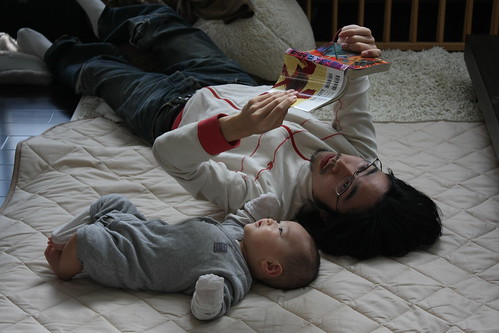Peter Gutiérrez, board member of Reading With Pictures, has just posted the first in an series of blog posts about “The Case for Adding Graphic Texts to Your Read-Alouds.” Upcoming posts will offer some specific strategies, but here’s the key part of his pitch:
To kids, reading comics (which are still not widely used in schools) is something more akin to spending time on a PlayStation than to doing anything “educational.” As with the best kidlit, reading graphic stories comes across as a leisure activity, pure and simple. Which is why reading such texts aloud is so effective as a literacy enhancer: children won’t notice that you’re reinforcing-and that they’re practicing-a wide range of skills, that you’re being a reading teacher rather than just a performer. Furthermore, as with any read-aloud, if your act of guiding kids through the text is done effectively, it will enhance their enjoyment of it and promote comprehension as well. It’s an interactive process that brings out humor, subtlety, and artistry that might otherwise go unnoticed. You can switch your focus from the print to the images and demonstrate how each supports, or even scaffolds, the reading of the other.
Gutiérrez explains that, stereotypes aside, comics books are neither picture books with smaller print, nor obstacles to “real” literacy with print-only, or print-centered, texts.
My six-year-old likes for me to read comics aloud to him–especially if he’s talked his mother into buying one that’s slightly too old for him. That way, if I silently edit the language, he knows exactly what the inappropriate parts are–which, of course, he promptly commits to memory!* But reading comics aloud has been good, because we can talk about the way the picture and the text work together, instead of just gazing at the pictures or skimming the words. We’ll sometimes read the giant collection of silver-age comics, such as Showcase Presents: Justice League of America, because it’s an easy way to learn about conventions, story arcs, and how we learn to expect certain things as readers. (Although I should’ve thought better about introducing the boy to Snapper Carr . . . snapping his fingers when he’s happy isn’t a habit I meant to encourage!)
Do you read graphic texts aloud to your kids? Have recommendations? Let us know in comments!
*It only took me a couple of tries to figure that out–although Byron had that sorted long ago:
Juan was taught from out the best edition,
Expurgated by learned men, who place
Judiciously, from out the schoolboy’s vision,
The grosser parts; but, fearful to deface
Too much their modest bard by this omission,
And pitying sore his mutilated case,
They only add them all in an appendix,
Which saves, in fact, the trouble of an index;
For there we have them all ‘at one fell swoop,’
Instead of being scatter’d through the Pages;
They stand forth marshall’d in a handsome troop,
To meet the ingenuous youth of future ages,
Till some less rigid editor shall stoop
To call them back into their separate cages,
Instead of standing staring all together,
Like garden gods-and not so decent either.




